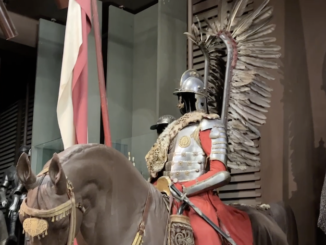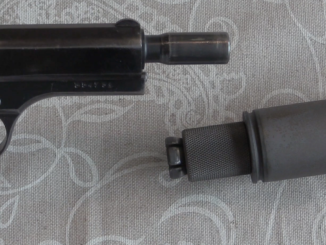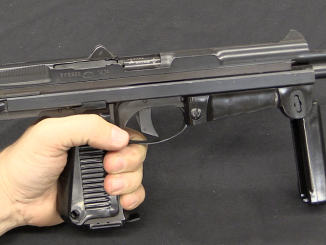Poland was one of the states which manufactured the Soviet PPS-43 submachine gun under license, but they decided to make a change to is in 1952. Where the original PPS-43 used a top-folding metal stock, the Poles decided to instead add a fixed wooden buttstock. This made the gun substantially more comfortable to shoot, and also less compact to transport. Was the tradeoff worthwhile? Let’s see how it shoots…
Thanks to Marstar for letting me examine and shoot their PPS-43/52!




It would be nice if you would show how this one (or any of your weapons) groups on a paper target at 50 m compared to a pps folder. It gives us an idea what practical accuracy means on a smg.
Did the Poles just saw the butt off surplus bolt action rifles and add them to this SMG?
They were building them brand new in their government factory: https://en.wikipedia.org/wiki/FB_%22Łucznik%22_Radom
So the overall verdict is: a butt-stock makes the gun only slightly better to shoot. Is there a way to put a buffering mechanism inside that receiver tube?
Perhaps, but it would also make it more expensive. The PPS-43 was basically the Soviet Sten, an SMG made as cheaply as possible. With that in mind it was a very successful design, because it was totally reliable, thanks to the well thought out magazine and magazine well. And like Ian said, you could still be very effective with it, although at longer ranges you would probably have to squeeze out single shots or two round bursts in order to hit anything.
Many firearm cogniscenti describe the reliability of Soviet firearms as a real virtue of them, for the most part, and with some exceptions. The failed/cancelled SVT-40 self-loauding rifle and AVT-40 automatic rifle being something of an exception.
Rarely do people venture into the magazine designs that underlie this reputation: The MP40 and Sten magazines remained real problems that were never entirely surmounted. And yet Sudaev produced a great magazine that led to a real breakthrough: The “Soviet Sten” is more reliable than the British version. It surmounted the problems of the PPSh41 Shpagin magazines that were not really interchangeable. Postwar, the Swedes created a stellar magazine for the Carl Gustaf m/45. Kalashnikov’s magazine is extremely reliable, as was Simonov’s SKS fixed magazine.
“Many firearm cogniscenti describe the reliability of Soviet firearms as a real virtue of them”
In 1940s, failure rate no bigger than …, was part of tactical-technical requirements of Main Artillery Directorate (name might suggest otherwise, but it was also responsible for fire-arms)
“failed/cancelled SVT-40 self-loauding rifle”
This need some explanation: only factory mass producing that rifle in 1941 was Tula Plant, with German invasion it needs to be evacuated, after that it do not produce SVT, however this does not mean that SVT-40 was failed – it required more resources to produce one SVT than one Mosin and with losses in 1941, there was big need to acquire rifles (fast), so Mosin was prefer.
–
Why there are some opinion of failed SVT? Because not users were enough trained in its maintenance, also most users measured its reliability against Mosin, if compared so it is bound to lose, but it is not fair – it should be compared against self-loading rifle not bolt-action repeating rifle. Naval Infantry, looking at photos, well liked SVT (along with a lot of sub-machine guns) – apparently there were able to train user enough to keep that particular pattern of rifle working.
https://che-ratnik.livejournal.com/388356.html
Also note that before SVT adoption there were over 100 different systems of self-loading rifles tested in Soviet Union, I doubt if they would accept that one of low reliability.
An accordion and some RPG-40 AT grenades: “Let’s get this party started!”
Thank you/ spacibo, Daweo. The dimensions of the “failure” of the SVT-40 appear in your learned reply, no? Perhaps “failed” seems too loaded a word, but a) it was too lightly built for the cartridge and hamstrung by the need to design it around the M1908 rimmed cartridge. The magazine is excellent. The gas system served as a point of departure for many other designs. b) it was too expensive to make, and as you indicated, in the colossal emergency and whole-sale transfer of war industry, the tooling and so on were limited to either designs from yesteryear, i.e. the vintovka 1891/30, or really simple but highly effective infantry weapons like the PPSh41–hampered by lack of magazine interchangeability as Ian has commented on. c) with the evacuation of the factory from Tula, and the role of the workers there changing to militia to defend the salient against Taifun/Typhoon, production sort of peters out. d) it was issued out to sailors, ’tis true. Also NCOs and more elite “guards” type soldiery thought more adept at dealing with its idiosyncracies, many parts, and fragility or sensitivity. Ammunition is the big issue here.
Certainly it was well liked and highly regarded by the USSR’s bitter enemies, who lacked a self-loader of their own for the most part. There was also the AVT variant, which was not very satisfactory as an automatic rifle. The SVT-40 was the sniper rifle in the first year or so of the Great Patriotic War, but soon replaced by the simpler vintovka 1891/30.
Respectfully, while the photos show that it was widely used–and even popular with–the marines who used it, the photo montage of photographs also shows U.S. made Thompsons provided through Lend Lease. My understanding is that the Thompson was not popular. Nor was the “coffin for 7 brothers” the Lee/Grant U.S. tank, nor the UK Hawker Hurricane fighter plane… Aircobra P39 was, Sherman was, Studebaker trucks, yes, the Willys jeep, and most especially tishonka/Spam canned meat-type product. The SVT-38 was the rifle adopted initially–and slated to replace the obsolete vintovka Mosina design. It didn’t work out all that well, and my understanding is that Tokarev, the designer, had something close to a nervous breakdown while his eminent and highly-trained staff and colleagues simplified the SVT-38 stock furniture and other miscellaneous parts into the SVT-40.
Again, thank you for the observations and the important counter arguments.
Proper designation of the gun is “pistolet maszynowy wzór 43/52”, usually (and oficially) abbreviated as “pm wz. 43/52” (“pistolet maszynowy” in Polish literally means “machine pistol” and is equivalent to the submachine gun; “wzór” means pattern of model and numeric designation is more or less a year of the weapon’s adoption).
Idea behind the modification of PPS was that in the Polish army of that time SMGs – and not rifles – were considered the primary weapon of infantry (until the advent of AK, which by the way initially was rated as “pistolet maszynowy” or SMG as well). Ideal SMG for infantry, i.e. having wooden stock was PPSh (pm wz. 41) but its manufacture had been quite expensive so after 110 thousand having been made it was to be stopped. Instead PPS was modified by the addition of the stock. Wz. 43/52 was being issued mainly to infantry/motorised units, while others (artillery crews, second line troops, services etc.) retained pm wz. 43 (i.e. PPS in its basic form). Eg. my father serving in the late 1950s in a signals regiment as a radiostation commander had pm wz. 43 (as well as his mates in the unit).
Of interest is that pm wz. 43/52 was exported at least to Cuba. Here you’ve got a photo of Cuban soldiers (probably of militia or other irregular formation) armed with the gun: http://www.opisybroni.republika.pl/images/pm%2043%2052%20Kub.jpg
Piotr
Interesting remark and picture, Piotr.
I suppose this was present “from Poland with love” guessing how Cubans appreciated it using white gloves.
Thank you Piotr.
The image shows the “Ejército Juvenil de Trabajo” or “Youth Labor Army.” This is one of the Cuban CP “mass organizations” such as the MTT or “Milicias de Tropas Territoriales. Unless I’m mistaken, the image you have there was taken in the late 1990s during the public ceremonies when Ernesto Ché Guevara was laid to rest in Santa Clara after his remains had been identified in Bolivia and transferred to Cuba for burial.
The straw hat tipped up in the front harkens back to the “mambíses” as the nationalist insurgents fighting against Spanish colonial rule in the 1870s and 1890s were nick-named. The hat itself appears on the MTT’s insignia, which as a party-led militia is mostly older folks and reservists, although there are also youngsters involved too. The EJT mostly works in the countryside and is typically young men doing their obligatory military service, or just before they go to serve in the FAR. So sort of “alternate” or “predecessor” to military service.
When I first saw those, I was naive and uninformed and assumed they were Cuban-made SMGs! Only later did I figure out the Polish provenance.
Incidentally, Piotr and others,
I have seen photographs of Cuban personnel–I’m just not sure if these were MINFAR–armed forces or MININT–interior ministry–in Angola during the military intervention there against South Africa and UNITA/Jonas Sovimbi carrying Polish PM-63s, something that I wouldn’t have expected to see in the Cuban revolutionary state’s inventories… Just goes to show how widely dispersed things got during the very many hot wars within the Cold War.
Good gun to see in action and good idea Ian ventured that far North!
When I visited Poland in early 60s I recall soldiers on border carried PPS with folding stock. Although I knew about existence and origin of this weapon it kind of collectively ‘shocked us’ (it was school trip) that Poles opted for such obsolescent weapon.
Comparison with Suomi may be bit out of place for two reason. One is of course greater muzzle impulse from Tokarev ammunition and second is Suomi’s weight; a rifle does not to be ashamed of this weight.
“Comparison with Suomi may be bit out of place for two reason. One is of course greater muzzle impulse from Tokarev ammunition and second is Suomi’s weight; a rifle does not to be ashamed of this weight.”
Well, there were developed in much different time, SUOMI yet in 1920s:
http://www.jaegerplatoon.net/MACHINEPISTOLS1.htm
so, it was measured against Great War-era sub-machine guns (like Bergmann) and pistolet maszynowy wzór 43/52 in, depending on your point of view, in 1940s (basic design) or 1950s (wooden stock iteration)
9mm Parabellum, at least with 8 gram (124 grain) bullets has a slightly higher muzzle impulse than 7.62mm Tokarev. With SMG barrels 9mm bullet momentum is 0.008kg × 380m/s = 3.04 kgm/s, standard ammo. Tokarev is 0.0055kg × 500m/s = 2.75 kgm/s. In practice there is not much difference, although the recoil from Tokarev might be slightly sharper due to higher muzzle velocity.
It must be noted that with hot-loaded SMG ammo 9mm will have somewhat higher momentum still. Finnish ammo from the Suomi SMG had a muzzle velocity of 390-400 m/s in summer conditions, somewhat less in freezing winter conditions. Italian super-hot 9mm was about 430 m/s with the MAB 38 (slightly less with later shorter barreled versions or the British Sten).
Ian; now that you have fired both the PPS-43 and the Finnish M/44 copy in 9mm Parabellum (a rather exclusive group of people, I might add): was there any difference in practical controllability? Any other notable differences except the magazines? (The magazine well of the M/44 is quite flimsy).
At the beginning of the video two dates have been used erroneously: should be: “made till 52” not till “42” (for obvious reasons). And once again later – the designation is 43/52 rather than “53”. Yeah, I am nitpicking. Sorry for that as this is quite an interesting video (as per ususal).
Nieźle Ian kropi, muszę powiedzieć!